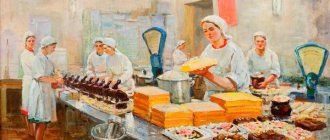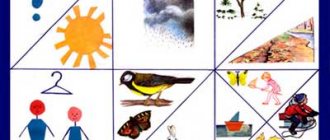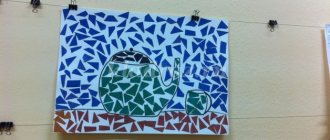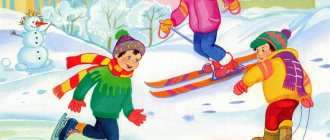DRAFTING A CREATIVE STORY FROM A PICTURE
Bakhtiyarova Natalya Nikolaevna Dubentsova Natalya Anatolyevna educators MBDOU DS No. 10 "Firefly" Starooskolsky urban district Burnasheva Olga Anatolyevna educator MBDOU "Obukhov kindergarten "Zemlyanichka" Starooskolsky urban district
COMPILATION OF A CREATIVE STORY FROM A PICTURE organized educational activity on speech development in a preparatory group for school
Target:
Create conditions for drawing up a creative story based on the picture.
Tasks:
- Teach children spatial orientation on a plane (picture) - activate in speech words denoting spatial orientations; teach an algorithm for narrowing the search field for an object on the picture plane.
- To develop in the child the skill of determining the composition of a picture; develop the skill of establishing the relationship of objects in a picture; develop the ability to transfer orientations of two-dimensional space into three-dimensional space.
- Develop communication skills.
Materials and equipment: projector, picture, sheets of paper, modules, magnetic board, petals of a seven-flowered flower.
Advertising message
Planned results: develop the ability to independently make speech sketches from a picture.
GCD move:
Educator: Now I will read you a fragment of the poem, and you will remember its title and author (reading a fragment of the poem “Drawing Summer” by E. Sokolova).
-What is this poem about? (children's answers)
— Let’s pick up “summer” words together: summer: heat, beach, green, warmth, rainbow, berries, travel, etc.; summer clothes: sundress, hat, panama hat, sandals, etc.; summer fun: badminton, roller skates, skateboard, ball, jump rope, sand games, swimming, etc.
— What is the weather like in summer? (hot, sultry, rainy, warm, cheerful, sunny, arid)
— What other works about summer fun do you know? (V. Berestov “Merry Summer”, A. Barto “In the Morning on the Lawn”, V. Bianchi “Summer”).
Educator: Now pay attention to the screen. What can you say about this picture? (What time of year? What is shown in the picture? What are the children doing? What are they playing? Who do we see in the picture, besides the children?
In order to highlight the objects depicted in the picture and name them, I suggest using a telescope. We can make it from a regular sheet of paper (roll up a sheet of paper). You just need to follow the rules: point the telescope at one object and describe it. I suggest dividing into groups (children are divided into two groups).
— You choose living objects. And you are lifeless. The one who lists the most objects in the picture wins (children's answers).
Educator: You and I saw a lot of objects in the picture, and they are all united with each other. For example: boy and girl. Why can they be connected? (Because a girl and a boy are playing ball). Right.
(The teacher sees a letter on the table).
- What is it? We received a letter from the wizard “Unite”:
“Hello, dear friends! I combined different objects. Please explain why I did this. And then try to select and combine objects in the picture as you wish. Your “Unite” wizard.
The wizard invites the children to explain why ducklings and water came together (because ducklings swim in water); boy - hose (a boy waters the garden with a hose); boy - basket (a boy collects apples in a basket), etc. (Children themselves identify two objects in the picture, justify the connection between them, generalize the most significant connections).
Educator: Now let's play a little, like the children in the picture.
Physical education minute:
The meadow is just like calico - running in circles on tiptoes, hands on the belt
A scarf of all colors - standing, crossing your arms, clasping your thumbs,
You won’t understand where the butterfly is - flapping your hands like wings
Where is the living flower? - sit down, raise and close your arms above your head
Forest and field in greenery - stand up, spread your arms to the sides
Blue river - swing your arms to imitate waves
White, fluffy - running in circles on tiptoes, hands on belt
There are clouds in the sky.
Educator: And now I suggest you revive our picture! We will turn into objects in the painting. But first we'll find out where they are. Let's use modules to denote trees. Where are they located? (right side, top, left side, top left corner). Choose an object that you like and find its place in the picture. Write a short story about where he is. I choose the bell flower. (I am a blue flower. They call me a bell because I look like one. I am on the left side of the picture. To my right is a yellow flower. In front of us is a boy and a girl playing with a ball.). Now you choose an object, tell us where it is, and find its place in our “living” picture.
Children select an object and describe its location on the plane (central part, left - right part of the picture, bottom - top part, left - right, top - bottom corners of the picture, closer - further, in front - behind, near, between, behind, in front, after). Children describe objects from the position of an outside observer or in the role of the object itself. (I am a girl. I am on the left side of the picture. I am wearing a red dress and purple shoes. To my right is a boy. We are playing ball, we are having a lot of fun!).
Educator: You coped well with a difficult task, and our picture came to life!
Now let's try to compose a short story based on our picture. To do this, we will choose a hero, tell him what he is like, where he is, what he does, whether he and those around him like it. And, of course, we’ll come up with a title for our story. (Children try to compose a story based on the picture).
Reflection: “Seven-flowered flower.” Children take turns collecting a flower from petals of different colors on a magnetic board and talk about what worked, what didn’t, and what still needs to be worked on. Then each child receives a gift - a seven-flowered flower.
Bibliography
- Ushakova, O.S., Strunina E.M. Speech development in children aged 6-7 years. - [With. 52]
- Alexandrova, O. V. Development of thinking and speech for children 4 - 6 years old / O. V. Alexandrova. - M.: Eksmo, 2013. - [p. 48]
- Gomzyak, O. S. Development of coherent speech in six-year-old children. Lesson notes / O. S. Gomzyak. - M.: TC Sfera, 2007. - [p. 96]
- Karpova, S. I. Development of speech and cognitive abilities of preschoolers 6-7 years old. 33 lexical topics / S. I. Karpova. - St. Petersburg: Rech, 2012. - [p. 144]
5. Nosenko, I. P. Development of children’s speech in preschool educational institutions (in diagrams and tables): Textbook/I. P. Nosenko. - M.: TsPO, 2009. - [p. 96]
Compiling stories based on plot pictures in the preparatory group
Alexandra Bocharova
Compiling stories based on plot pictures in the preparatory group
In classes in a preparatory group for school, a teacher’s model should be offered only if the children have poor ability to coherently present the content of a picture . In such classes, it is better to give a plan, suggest a possible plot and sequence of the story . In groups of senior preschool age, all types of stories based on a picture : a descriptive story based on subject and plot paintings , a narrative story , a descriptive story based on a landscape painting and still life .
You can widely use a story based on a series of pictures (for example, on the topic “Our site in winter and summer”
, where what is required is no longer a simple listing of ongoing events, but a consistent
story with a beginning , culmination and denouement. The conversation on issues that precedes the story concerns the main points, the key points of the depicted plot .
improve the ability to tell stories based on a series of pictures : compiling a collective story - the teacher begins the story , the children finish; One child starts, another continues.
In the preparatory group, children are first introduced to composing narrative stories . So, they come up with a beginning or an end to the plot depicted in the pictures : “That’s how it went for a ride!”
,
“Where did you go?”
,
“Gifts for Mom for March 8th”
,
“The Ball Flew Away”
,
“Cat with Kittens”
, etc. A clearly formulated task encourages you to creatively complete it.
It is very important to teach children not only to see what is depicted in the picture , but also to imagine previous and subsequent events. For example, based on these pictures, the teacher can ask the following questions: What did the guys say to the boy? ( "That's how I rode!"
);
How did the children prepare gifts for their mother? ( "March 8"
);
who put the basket here and what happened? ( "Cat with Kittens"
).
Several questions may be asked, as if outlining the plot line of the narrative story : where did these children come from? What happened to them next? How did these children continue to be friends? ( "Waiting for guests"
)
The same picture can be used several times during the year, but different tasks should be set, gradually making them more difficult. When children master free storytelling , you can offer them two or more paintings (already seen and even new ones)
and set a task - to come up with
a story based on any picture . This will give them the opportunity to choose the content that is most interesting to them, and for those who find it difficult, an already familiar plot , which is easy to use to compose a story .
Such activities develop independence and activity, and foster a sense of self-confidence. In the senior and preparatory groups, work continues to develop the ability to characterize the most significant things in a picture . The emphasis on what is essential comes out most clearly in the selection of the name of the painting , so children are given tasks like “What did the artist call this painting ?”
,
“Let’s come up with a name”
,
“What can we call this
picture ?” .
Along with highlighting and characterizing the most essential, one must learn to notice details, convey the background, landscape, , etc. d.
The teacher teaches children to introduce short descriptions of nature stories Of great importance in this case is such a methodological technique - analysis of the teacher’s story . Children are asked questions: “Where did I start my story ?”
,
“How is my
story different from Alyosha’s story ?” , “How did I
talk about the time of year depicted in the picture ?”
Gradually, older preschoolers learn to supplement their stories based on the picture with a description of the depicted landscape, , etc. d. Here, for example, is the beginning of Marina’s story (6 years old)
based on
the painting “That’s how I rode!”
: “This
picture depicts winter .
The day is sunny and cold. And the sky is all colorful. It’s because of the sun that it glows so much.” The introduction of such small descriptions a story based on a painting prepares children for composing stories based on landscape paintings and still lifes . This type of storytelling is used in the pre-school group .





